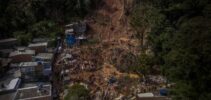What is leprosy or leprosy? Disease caused by a bacteria called Mycobacterium leprae (M.leprae). Transmission occurs through the respiratory tract. It targets the nerves, especially those located in the skin. The defense cells initiate a reaction to destroy it, which also reaches the nerves, and withpromeaffect their functioning and that of other parts of the body, causing loss of sensitivity. (Source: Brazilian Society of Pathology)
ADVERTISING
Last year, there were almost 15 thousand new cases of leprosy in Brazil, according to preliminary figures released by the ministry. Maranhão, Mato Grosso, Pernambuco, Bahia and Pará are the states that lead the records.
The data come from an epidemiological bulletin on the disease recently published by the Ministry of Health.

Along with Indonesia, Brazil and India account for almost 75% of global registrations. In the Americas region, 92,4% of cases registered in 2021 occurred in Brazil.
ADVERTISING
Also according to the bulletin, around a third of patients already had grade one physical disability (when there is loss of sensitivity in the extremities) and almost 1.500 patients already had grade two disability.prometenment (more serious injuries), most often permanent physical disabilities.
Challenge
One of the challenges in combating the disease is precisely being able to make the diagnosis, as it is mainly done clinically. As the disease progresses slowly, symptoms are not always evident, meaning the diagnosis is often made late.
“We still miss many cases. There is a hidden endemic”, says infectious disease specialist Márcio Gaggini, consultant at the Brazilian Society of Infectious Diseases and member of the Brazilian Society of Hansenology. “Therefore, we were unable to break the transmission cycle.”
ADVERTISING
According to the expert, more investment is needed in training health professionals, as well as access to modern diagnostic techniques to detect the disease.
cone disease
If not treated soon, the physical changes may be irreversible. The treatment is long – it can take from six months to a year – and involves the use of antibiotics.
In Brazil, the National Strategy for Combating Leprosy establishes goals until 2030 to interrupt the transmission chain, reducing the number of new cases and late diagnoses in which there is a high degree of physical disability.
ADVERTISING
One of the objectives is also to propose actions to combat stigma and discrimination against these patients, who, if they are undergoing treatment, no longer transmit the disease.
Source: Einstein Agency
Curto Curatorship:
Leprosy symptoms (Drauzio Varela)
- Brown, whitish or erythematous spots on the skin, sometimes barely visible and with imprecise boundaries;
- Change in temperature in the area affected by the stains;
- Withpromeperipheral nerve tension;
- Numbness in some areas of the body caused bypromeenervation. Loss of local sensitivity can lead to wounds and loss of fingers or other parts of the body;
- Appearance of lumps or swelling in the coldest parts of the body, such as ears, hands and elbows;
- Changes in skeletal muscles, especially those in the hands, which results in the so-called “claw hands”;
- Infiltrations and edemas on the face that characterize the leonine face, characteristic of the lepromatous form of the disease.
See also:




